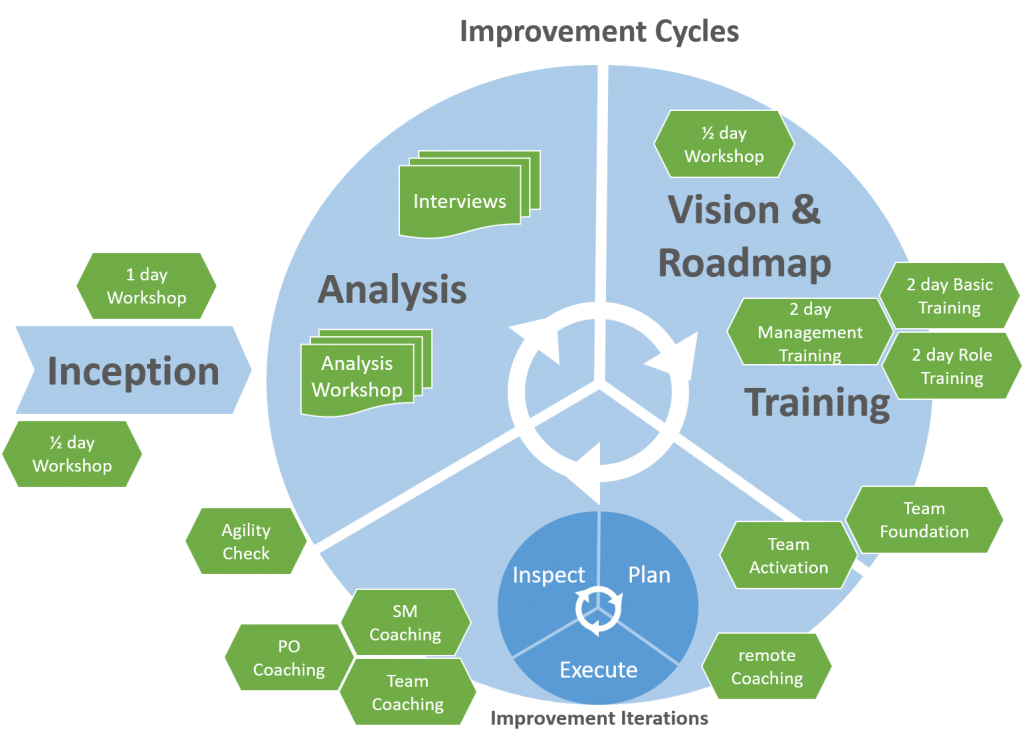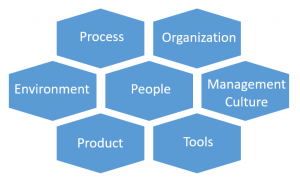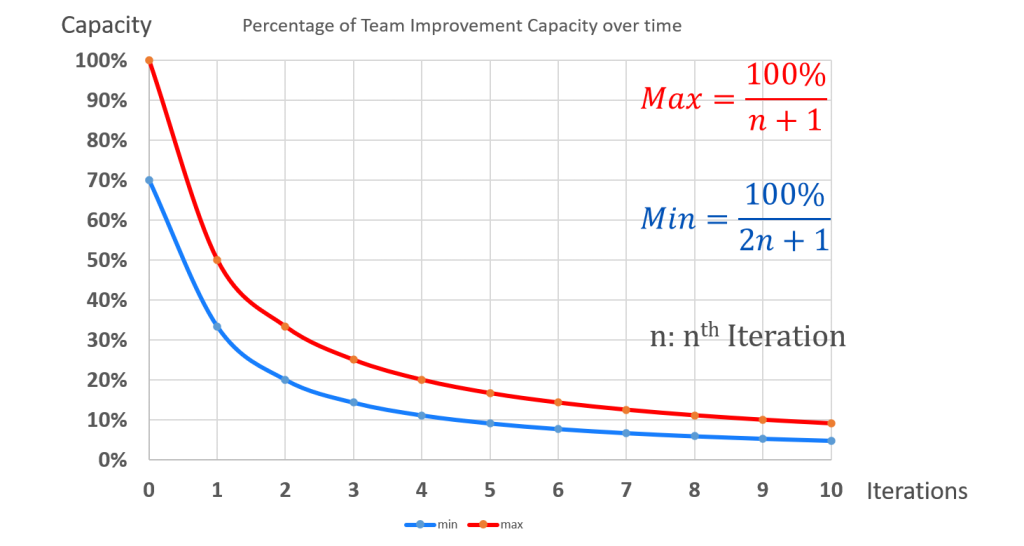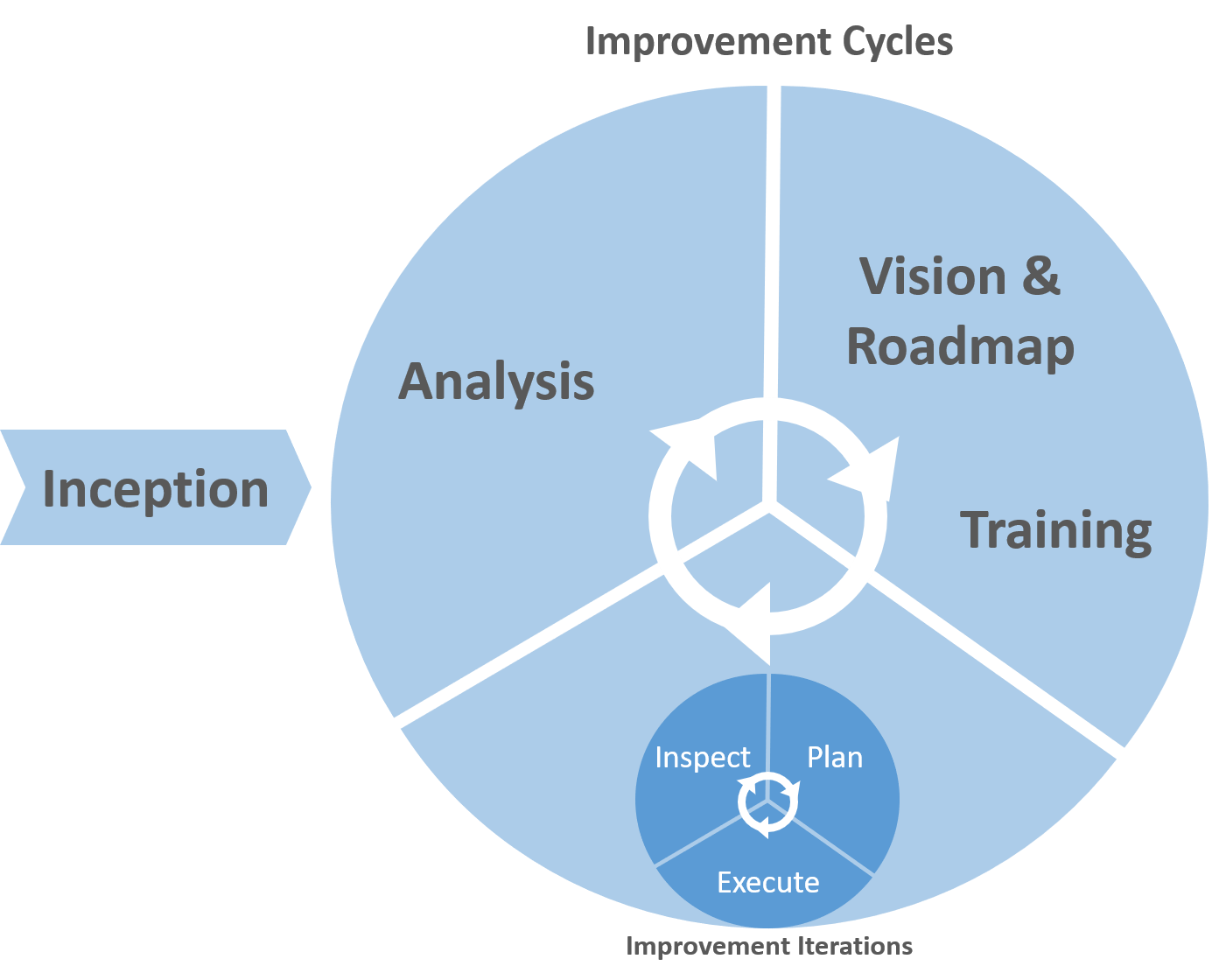The introduction of agile methods, practices and organizational structures according to the P4 framework is – as usual – also based on agile principles:
- incremental: The organization starts in the most suitable part and lets the methods, practices and structures grow organically, i.e. according to the needs of the organizational parts. This can also mean that changes occur in areas that are already agile if other parts of the organization are “integrated” into the agile transition.
- iterative: The “spread” of the agile way of working within the organization takes place gradually in planned cycles, whereby the rough plan (i.e. the roadmap) is adapted iteratively.
- holistic: It is about taking into account all aspects of the organization and its stakeholders (employees, markets, products, technologies, processes, environment, suppliers, …) so as not to optimize locally.
The introduction of P4 actually takes place in two nested cycles:
- The outer, larger cycle (cycle) which, after an initial preparation phase (inception), goes through the phases Analysis, Vision & Roadmap, and iterative introduction. We assume that each cycle take several months.
- The inner, smaller cycle in iterations, which carries out the measures for introduction into the planned organizational parts. The iterations consist of the elements plan, execute, inspect and are carried out synchronously with the iterations of the teams (mostly with a slight phase shift). The iterations are shorter periods, between two and four weeks. As a result, the introduction merges with the activities of the Team Scrum Master Group or the Cluster Scrum Master Group after they have been founded.
Perhaps you have noticed in the illustration, that there is no real end to the agile journey. In fact we assume that due to external or internal changes in the framework conditions, changes will be necessary (because of the VUCA environment) and even if this should not be so intensive, there is always something that can be improved.

Inception Phase
Description and objectives:
In this phase the management is informed and trained by internal or external P4 management consultants. Thereby the expectations of the organizational management are clarified and coordinated, and the chances and the possible procedure for an agile transformation are presented. This also includes the personnel, time and cost aspects of such a transformation.
In an (optional) second workshop, agile practices will be presented in depth, the current problems and impediments will be concretized and improvement possibilities will be recorded in the form of a so called “Improvement Backlog”. This is the base information for subsequent phases.
Activity examples:
- Workshops to determine the current status of the organization. This also includes problem areas and suggestions for improvement from the organization
- Participation of managers in conferences or training courses on the subject of “New Work” and “Pragmatic Agile Management”
- Literature research and reading, reading, reading!
- Alternatively and in addition, consultants can be involved
Analysis Phase
The Analysis of the current state is based on the fact that changes within the company are implemented in subsequent phases. These changes can only be achieved if the products to be developed, the technologies used, but also processes, methods, tools, organizational structure and people are considered equally as well as management culture. Successful changes require the consideration of all these topics.

Description and objectives:
The Analysis of the current state aims to identify and evaluate the potential for improvement in order to verify and refine the objectives for the subsequent phases.
Activity examples:
- Formation of the Pragmatic Transformation Team (PTT) as the core team for the implementation and information of the Pragmatic Agile Transformation , as well as a steering committee consisting of managers who are responsible for the organization (PTSC = Pragmatic Transformation Steering Committee)
- Interviews with the managers, the employees of the organizational unit concerned (for example R&D), and the adjacent organizational units (for example PM, Q, Production, Service).
- Planning of interviews
- Execution and follow-up of interviews
- Consolidation of interview results
- Analysis of documented and lived processes
- Conducting a moderated SWOT analysis workshop with the relevant participants of the organization
- Presentation of the results to the organizations management
- Presentation of the results to the analyzed organization
Agility Check within the Analysis Phase
Description and objectives:
After the first implementation cycle, the organization’s Scrum Masters have already created improvement backlogs. If the introduction of agility was started beforehand with a different framework, an analysis and the creation of an improvement backlog can also be created through the support of events by internal or external consultants.
Activity examples:
- Analysis of Scrum events
- Planning events
- Review events
- Retrospectives
- Conducting a “Big Retrospective” or workshops
- Interviews with relevant persons
- Presentation of the results to the organizations management
- Presentation of the results to the analyzed organization
Vision & Roadmap
Description and objectives:
After the improvement proposals have been presented and analyzed in the form of an Improvement Backlog, the responsible managers and a delegation of employees of the organization develop a Vision of the target status and a Roadmap of basic activities for achieving the target status. The results of this phase serve as orientation for the implementing team (Pragmatic Transformation Team) and the employees within the teams under consideration.
Activities:
- If not done already: Formation of the Pragmatic Transformation Team (PTT) as the core team for the implementation and information of the Agile Transformation , as well as a steering committee consisting of managers who are responsible for the organization (PTSC = Pragmatic Transformation Steering Committee)
- Workshop for the development of a Vision and the Roadmap of the Pragmatic Transformation
- Preparation and planning of the workshop
- Execution (1/2 or 1 day)
- Post-processing, preparation and documentation of the Vision and the Roadmap
Training & Start
Description and objectives:
- Creation of a common understanding about possibilities, goals, vision and the roadmap
- Creation of a robust foundation and the clarification of terms and their meaning (What is Agility)
- A clear understanding, why, what and how first changes are implemented and conducted
- Teams are formed for their startup, set up, have a team backlog, and can perform initial iterations.
Activity examples:
- Scrum/P4 basic training for teams
- Scrum/P4 training for managers
- Team Foundation Workshop to define the structure of Teams, Groups and Cluster, as well as the Nucleus Team Members, Extended Team Members, Supporters, Stakeholders, Team Product Owners, Team Scrum Masters and Team System Engineers
- Definition of interfaces to other (potentially non-agile) organizationen, groups and teams
- Definition of the “Cadence of Events”, depending on the scope of the transition, of the Cluster events and the Team events and how the interfere
- Team Activation-Workshop: Setting up a new Team, defining roles & responsibilities, team boundaries, deliverables from/to other teams. Creating an application/Product/system vision, setting up an initial Team Backlog with further organizational goals & tasks, and first product development goals.
Execution Phase: Iterate planning, execution, inspection and adaption
Description and objectives:
Iterative planning and implementation is the central element of an Pragmatic Transformation. Depending on the Roadmap, there can be several increments or roll-out waves (planned in Cycles), whereby, for example, additional teams or organizational units are transformed.
Planning and implementation in the PTT is organized as an agile team, i.e.
- in fixed time-boxed iterations
- with an interdisciplinary team of all participating organizational units
- with an improvement-backlog from which specific topics are planned for each iteration
- an iteration goal for each iteration
- an iteration backlog in which the topics are refined into tasks.
- The progress of the Pragmatic Transformation is visualized by a Scrum or Kanban Board, which shows the completion of the tasks and topics.
The PTSC represents the sponsor and stakeholders of the Pragmatic Transformation within the organization.
- it adapts the “direction” with the Pragmatic Transformation by supplementing and prioritizing the Improvement Backlog at the beginning of an Iteration.
- it evaluates the results at the end of an Iteration.
- it removes obstacles and impediments to the Pragmatic Transformation
The piloting teams are working on their product development activities using agile principals and methods. No special sandbox projects are set up, so that the influences of agile work can be evaluated immediately, and improvements can also be used directly.
The following diagram helps the organisation to avoid investing too much working time in the implementation of the changes and improvements on the one hand, while on the other hand it also describes the expectation of how much working time all those involved should invest minimally in the implementation.

Activity examples:
- Further trainings (e.g. Agile Systems Engineering, Agile Requirements Engineering, Agile Testing, Agile Documentation)
- Team Activations: Workshops for setting up teams and the roles (e.g. Team Product Owner, Team Scrum Master , Team Systems Engineer) and setting up an initial Team Backlog
- Supporting and consulting teams by the Cluster Scrum Master or external Agile Coaches
- Agile Coaches advising the PTT on topics such as: Tools, documentation, process descriptions (as interface to the quality management manual)
- Orientation and information events for employees inside and outside the organizational units
- Implementation and moderation of team events such as Iteration Planning, Iteration Review, Refinements and Retrospectives
At the end of each cycle the groups and teams within the organization are re-analyzed within a Cycle Retrospective and, if necessary, changed or new ones created. Team Foundation Workshops can be repeated for this. This means that the organization is constantly being adapted to the changing conditions.
Next article: Comparing classical, agile and pragmatic development | News | Back to FAQ | Home
